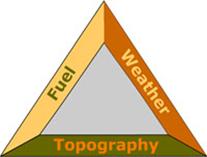
 South
Canyon Fire South
Canyon Fire
1994
6 Minutes for Safety — 2009
Fire Behavior Report, 1998
Fire Environment
- July 2 to
Evening of July 5
- July
5, 2230 to July 6, 1530
- July 6, 1530
to 1600
- July 6, 1600
to 1603
- July
6, 1603 to 1609
- July 6, 1609
to 1610
- July 6, 1610
to 1611
- July 6, 1611
to 1614
- July 6, 1614
to 1623
- July
6, 1622 to 1830
- July
6, 1830 to July 11
References
Appendix A
Appendix B
Appendix C
|
 |
|
|
Today's discussion is from
“This Day in Wildland Fire History”
“Lessons Learned” serve as brief summaries of powerful learning opportunities. You can use these summaries as a foundation and launch point for further dialogue and discussion. Apply these lessons learned to yourself, your crew, and your unit. |
South Canyon Fire, Colorado, 1994 (A Four-Part Series) |
Incident Summary: On July 2, 1994, seven miles west of Glenwood Springs, Colo., lightning ignites a Bureau of Land Management fire in pinyon-pine juniper on a ridge at the base of Storm King Mountain. The fire, paralleled by two deep canyons, is initially believed to have “little chance” to spread. The past two days, lightning has started 40 new fires on this BLM District. The entire general area, in a one-year drought, is experiencing low humidities and record-high temperatures. Over the next two days, the South Canyon Fire increases in size. Visible from Interstate 70 and nearby residential areas, the public becomes concerned. Some initial attack resources are assigned. Between July 3-6, the fire grows to approximately 2,000 acres. On July 6, a dry cold front moves into the fire area. As winds and fire activity increases, the fire makes several 100-foot flame-length rapid runs within the existing burn—in dense, highly flammable Gambel oak. Fourteen firefighters perish as they try to outrun the flames. The remaining 35 firefighters survive either by escaping down a deep drainage or by seeking a safety area and deploying their fire shelters.
|
July 3 – Summary of Activities
The Grand Junction BLM District is in very high to extreme fire danger. Ninety percent of its firefighting resources are committed to more than 40 new fires started in the previous 2 days.
A red flag warning is issued for dry lightning. Strong winds hamper the effective use of fire suppression aircraft.
One load—eight—smokejumpers, an air tanker, and lead plane are requested.
An engine crew arrives on scene. Its foreman’s initial size-up informs: fire is inaccessible, two flaming trees visible, low spread potential, steep slopes. Until more resources can be obtained, it is recommended that the fire be observed.
Fire Control Officer requests more South Canyon Fire resources from the Western Slope Fire Coordination Center. |
|
Lessons Learned
Discussion Points
Your fire crew is now dispatched to the South Canyon Fire. Given the following circumstances, what would you do to ensure that everyone is safe:
-
Extreme fire danger due to condition of the fuels,
-
Limited resources,
-
Difficult terrain,
-
Red flag warning for dry lightning and high winds.

|
References
“This Day in Wildland Fire History” is a collaborative project between
“6 Minutes for Safety” and the Wildland Fire Lessons Learned Center.
<<< continue
reading—South Canyon Fire, 6 Minutes for Safety, July 4 >>>
|
|
